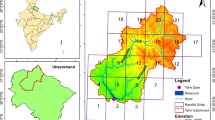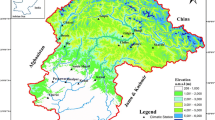Abstract
The analysis of precipitation intensity and frequency should be conducted on data with high temporal resolution, such as hourly precipitation data. This study focuses on the spatial distribution and temporal variation of precipitation intensity and frequency in the Yarlung Zangbo River basin during 2008–2017, based on a merged hourly precipitation dataset with 0.1° of latitude/longitude spatial resolution. The hourly precipitation intensity is represented as the mean accumulated amount in each observation hour and the precipitation frequency is the proportion of precipitation hours in this study. The multi-year mean values and temporal changes of precipitation intensity and frequency are compared at annual time scale, during the warm season (from May to October) and cold season (from November to the next April), as well as among the upper, middle and lower basins. For the whole stream region, the mean hourly precipitation intensity is 0.92 mm/h during the warm season, larger than 0.69 mm/h during the cold season. The mean precipitation frequency is about 7.79% during the warm season, larger than 4.40% during the cold season. For the sub-region, the mean hourly precipitation intensity and frequency are largest for the lower basin during the warm season (1.10 mm/h and 10.62%), whereas largest for the upper basin during the cold season (0.86 mm/h and 4.26%). The hourly precipitation intensity increases during the warm season but decreases during the cold season. The precipitation frequency continuously decreases with larger tendency during the warm season than that during the cold season.




Similar content being viewed by others
References
Allan RP, Soden BJ (2008) Atmospheric warming and the amplification of precipitation extremes. Science 321:1481–1484
Allan RP, Zveryaev II (2011) Variability in the summer season hydrological cycle over the Atlantic–Europe region 1979–2007. Int J Climatol 31:337–348
Allan RP, Soden BJ, John VO et al (2010) Current changes in tropical precipitation. Environ Res Lett 5:302–307
Allen MR, Ingram WJ (2002) Constraints on future changes in climate and the hydrologic cycle. Nature 419:224–232
Bao J, Sherwood SC, Alexander LV et al (2017) Future increases in extreme precipitation exceed observed scaling rates. Nat Clim Change 7:128–133
Barbero R, Fowler HJ, Lenderink G et al (2017) Is the intensification of precipitation extremes with global warming better detected at hourly than daily resolutions? Geophys Res Lett 44:974–983
Buonomo E, Jones R, Huntingford C et al (2007) On the robustness of changes in extreme precipitation over Europe from two high resolution climate change simulations. Q J R Meteorol Soc 133:65–81
Chang W, Stein ML, Wang J et al (2016) Changes in spatiotemporal precipitation patterns in changing climate conditions. J Clim 29:8355–8376
Donat MG, Lowry AL, Alexander LV et al (2016) More extreme precipitation in the world’s dry and wet regions. Nat Clim Change 6:508–513
Fan J, Sun W, Zhao Y et al (2018) Trend analyses of extreme precipitation events in the Yarlung Zangbo River basin, China using a high-resolution precipitation product. Sustainability. https://doi.org/10.3390/su10051396
Fischer EM, Knutti R (2016) Observed heavy precipitation increase confirms theory and early models. Nat Clim Change 6:986–991
Goudenhoofdt E, Delobbe L (2009) Evaluation of radar-gauge merging methods for quantitative precipitation estimates. Hydrol Earth Syst Sci 13:195–203
Hegerl GC, Black E, Allan RP et al (2014) Challenges in quantifying changes in the global water cycle. Bull Am Meteor Soc 96:1097–1115
Held IM, Soden BJ (2006) Robust responses of the hydrological cycle to global warming. J Clim 19:5686–5699
Hirsch RM, Archfield SA (2015) Flood trends: not higher but more often. Nat Clim Change 5:198–199
Kharin VV, Zwiers F (2000) Changes in the extremes of an ensemble of transient climate simulations with a coupled atmosphere–ocean GCM. J Clim 13:3760–3788
Kharin VV, Zwiers F (2005) Estimating extremes in transient climate change simulations. J Clim 18:1156–1173
Lei YB, Yang K, Wang B et al (2014) Response of inland lake dynamics over the Tibetan Plateau to climate change. Clim Change 125:281–290
Li F, Zhang Y, Xu Z et al (2013) The impact of climate change on runoff in the southeastern Tibetan Plateau. J Hydrol 505:188–201
Li F, Xu Z, Liu W et al (2014) The impact of climate change on runoff in the Yarlung Tsangpo River basin in the Tibetan Plateau. Stoch Environ Res Risk Assess 28:517–526
Lin M, Huybers P (2019) If rain falls in india and no one reports it, are historical trends in monsoon extremes biased? Geophys Res Lett 46:1681–1689
Lin C, Chen D, Yang K et al (2018) Impact of model resolution on simulating the water vapor transport through the central Himalayas: implication for models’ wet bias over the Tibetan Plateau. Clim Dyn 51:3195–3207
Liu Z, Yao Z, Huang H et al (2014) Land use and climate changes and their impacts on runoff in the Yarlung Zangbo river basin, China. Land Degrad Dev 25:203–215
Liu JP, Zhang WC, Liu T et al (2018) Runoff dynamics and associated multi-scale responses to climate changes in the middle reach of the Yarlung Zangbo River Basin, China. Water. https://doi.org/10.3390/w10030295
Luo Y, Wu M, Ren F et al (2016) Synoptic situations of extreme hourly precipitation over China. J Clim 29:8703–8719
Portmann RW, Solomon S, Hegerl GC et al (2009) Spatial and seasonal patterns in climate change, temperatures, and precipitation across the United States. Proc Natl Acad Sci USA 106:7324–7329
Prein AF, Rasmussen M, Ikeda K et al (2017) The future intensification of hourly precipitation extremes. Nat Clim Change 7:48–53
Scherrer SC, Posselt FR, Liniger MA et al (2016) Emerging trends in heavy precipitation and hot temperature extremes in Switzerland. J Geophys Res Atmos 121:2626–2637
Shen Y, Zhao P, Pan Y et al (2014) A high spatiotemporal gauge-satellite merged precipitation analysis over China. J Geophys Res Atmos 119:3063–3075
Sun F, Roderick ML, Farquhar GD (2018) Rainfall statistics, stationarity, and climate change. Proc Natl Acad Sci USA 115:2305–2310
Trenberth KE (2011) Changes in precipitation with climate change. Clim Res 47:123–138
Trenberth KE, Zhang Y (2018) How often does it really rain. Bull Am Meteorol Soc 99:289–298
Trenberth KE, Dai A, Rasmussen RM et al (2003) The changing character of precipitation. Bull Am Meteorol Soc 84:1205–1217
Trenberth KE, Zhang Y, Gehne M (2017) Intermittency in precipitation: duration, frequency, intensity and amounts using hourly data. J Hydrometeorol 18:1393–1412
Wang Y, Yang K, Zhou X et al (2019) The formation of a dry-belt in the north side of central Himalaya Mountains. Geophys Res Lett 46:2993–3000
Wang Y, Yang K, Zhou X et al (2020) Synergy of orographic drag parameterization and high resolution greatly reduces biases of WRF-simulated precipitation in central Himalaya. Clim Dyn 53:1–12
Wasko C, Sharma A (2015) Steeper temporal distribution of rain intensity at higher temperatures within Australian storms. Nat Geosci 8:527–529
Westra S, Fowler HJ, Evans JP et al (2014) Future changes to the intensity and frequency of short-duration extreme rainfall. Rev Geophys 52:522–555
White RH, Battisti DS, Skok G (2017) Tracking precipitation events in time and space in gridded observational data. Geophys Res Lett 44:8637–8646
Xie P, Xiong A (2011) A conceptual model for constructing high-resolution gauge-satellite merged precipitation analyses. J Geophys Res Atmos. https://doi.org/10.1029/2011JD016118
Xu Z, Gong TL, Li JY (2008) Decadal trend of climate in the Tibetan Plateau-regional temperature and precipitation. Hydrol Process 22:3056–3065
You Q, Kang S, Wu Y et al (2007) Climate change over the Yarlung Zangbo River Basin during 1961–2005. J Geog Sci 17:409–420
Zhou C, Wang K (2017) Quantifying the sensitivity of precipitation to the long-term warming trend and interannual–decadal variation of surface air temperature over China. J Clim 30:3687–3703
Zhou T, Yu R, Chen H et al (2008) Summer precipitation frequency, intensity, and diurnal cycle over China: a comparison of satellite data with rain gauge observations. J Clim 21:3997–4010
Acknowledgements
This work is supported by the National Natural Science Foundation of China (Grant No. 91647202), the National Basic Research Program of China (Grant No. 2015CB953703), the National Natural Science Foundation of China (Grant Nos. 41405098 and 41705086) and the Fundamental Research Funds for the Central Universities. The authors are grateful to China Meteorological Administration for providing the merged precipitation data and the station precipitation data.
Author information
Authors and Affiliations
Corresponding author
Ethics declarations
Conflict of interest
The authors declare that they have no conflict of interest.
Additional information
Responsible Editor: A.-P. Dimri.
Publisher's Note
Springer Nature remains neutral with regard to jurisdictional claims in published maps and institutional affiliations.
Rights and permissions
About this article
Cite this article
Wu, G., Zhao, R., Ma, Z. et al. The hourly precipitation intensity and frequency in the Yarlung Zangbo river basin in China during last decade. Meteorol Atmos Phys 132, 899–907 (2020). https://doi.org/10.1007/s00703-020-00730-9
Received:
Accepted:
Published:
Issue Date:
DOI: https://doi.org/10.1007/s00703-020-00730-9




